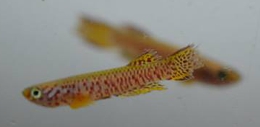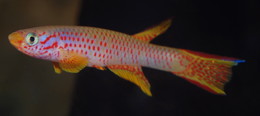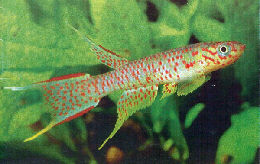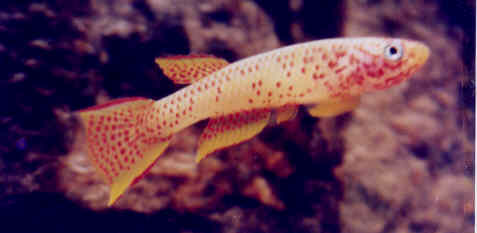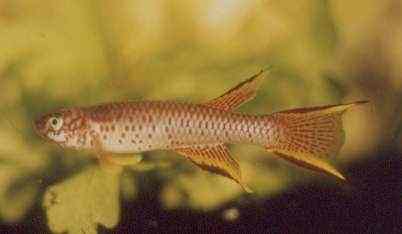| Meaning of Name |
Elegant | ||||||||
| First Description |
Boulenger 1899. Matérieaux pour la faune du Congo, Tomé I, Poissons nouveaux. Annales du Musée du Congo belge, 1: 112-114, plate 47, figure 2. | ||||||||
| Size |
5 cm | ||||||||
| Meristics |
| ||||||||
| Karyotype |
n = 10, A = 18 (Huber & Scheel 1981) | ||||||||
| Sub-Genus |
Aphyosemion | ||||||||
| Group |
elegans | ||||||||
| Synonyms |
| ||||||||
Populations
Aphyosemion affinis elegans
|
Bombala - RPC 83 / 2. Collected by Christophe Moreau in 1983.
Madimba - Collected by W.Wachters in 1979. Introduced to the BKA in 1980 by SIC where they were distributed as Aphyosemion sp. Madimba. In the UK they were also distributed as A.cognatum Madimba.
JH 134 & 137 - These populations have been erroneously given as RPC in some articles & were collected by Dr.J.H.Huber (see JH78 code) in northeast Congo-Brazzaville in 1978. These collections lack the red band in the dorsal fin seen more commonly in collections further to the north. The red band in the caudal fin is marginal & not submarginal as in other populations. It is possible these may not be elegans. Lui Kotale - Collected by Ulrich Schliewen
in 2002 in the Province of Bandundu, Democratic Republic of Congo.He
also collected at Lompolé but these were not brought back to
captivity. A yellow form was also collected at Km 14 which may be elegans. | ||||||||
| Type Locality |
Bikoro (Lake Tumba, Central Congo drainage) & Mbandaka, central Zaire. Also Coquilhatville, close to the Congo River (currently Mbandaka).
| ||||||||
| Distribution |
Widespread distribution across the central Zaire River drainage. | ||||||||
| Habitat |
Small, shallow streams & brooks. Also found in swampy
areas of pools & along the shore line of lakes. Prefers shallow water with
slow currents in forested areas. | ||||||||
| Distinguishing Characteristics |
The main distinguishing character of this sp.
is regarded as the striated body pattern. The photo at the top of this
page clearly shows this. Boulenger wrote in his work 'Catalogue of the
Freshwater Fishes of Africa in the British Museum (Natural History)'
-'Yellowish or pale olive, brown on the back, most of the scales edged
with carmine; vertical fins with carmine dots & edged with carmine
or dark purple'. | ||||||||
| Colour/Pattern Variability | High | ||||||||
| History |
Boulenger described Haplochilus
elegans from 3 (Types 1-3) specimens caught by Delhez at
Bikoro on Lake Tumba in 1899. Boulenger gives the following collectors / locations in his 1915 Catalogue.
Nichols & Griscom in 1917 reported fish caught at Medje, Faradje & Stanleyville as belonging to elegans. These fish were used by Myers in 1924 to describe A.castaneum. In 1952 Poll reported having numerous fish caught in affluents to the left of the Congo (Zaire) River) (Mondimbi, Flandria, Eala, Kunumgu & Bikoro) & also from Genema, Ubangui drainage. Matthes in 1964 had 82 fish from Lake Tumba. J.Lambert collected them at Boende about 300 km east of the type locality. These were returned alive to Belgium. Some of this collection is preserved in the Museum of Central Africa, Tervuren, Belgium. This collection was known to still be in the hobby in 1973. Known to be circulating in the BKA in 1980. | ||||||||
| Breeding Notes |
Although they have been seen in auctions now & then they are reportedly a little harder to breed & maintain following generations. Subdued lighting seems to be important. Stan Langdon in BKA newsletter No.186, February
1981 gave the following breeding report. I know Stan, & he is does
nothing but methodical. At the 2003 BKA convention I had a talk with Ian Sainthouse on how the old BKA import of this sp. was bred & he informed me that eggs should be incubated on a bed of wet peat for success. Water incubation resulted in most if not all eggs disintegrating. | ||||||||
| Diameter of Egg | 0.9mm | ||||||||
| Remarks |
Care should be excercised in putting fish into new surroundings. A towel should be placed over the tank to keep it dark for a few days as this sp. seem to dislike new surroundings. Males will extend finnage in fighting posture but damage between males has been reported as being minimal. |
